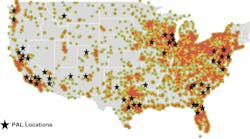Hitting the simulators instead of the highway
All new drivers have to solo. At some point, they have to leave the comparative security of the training environment and get out there on the highway with other drivers to polish their skills in the real world. There will be a first time for driving in the snow and ice, a first time dealing with a blow-out, a mountain grade, an emergency stop.
Now a company in Utah is offering new drivers and seasoned professionals a way to experience real-world driving conditions without the real-world risk. I-Sim Corp. develops and produces a variety of vehicle simulators to help enhance safety and improve driver performance. "We work to help all drivers get better at what they do," says Darren Somsen, marketing programs manager.
I-Sim was formed in October 1994. Today the company offers a range of simulators for driver training in the trucking, military, research and emergency vehicle markets. There's even a simulator specifically designed for law enforcement officials called PatrolSim.
The San Antonio Police Dept., for example, recently credited its new PatrolSim unit with reducing intersection accidents involving police officers by about 75%."We believed a driving simulator would augment our training program by allowing officers to practice different driving scenarios without injuring themselves or damaging vehicles," reported Ernest Trevino, driving instructor for the SAPD. "The I-Sim simulator has literally saved lives in San Antonio,"
While truck drivers don't have to worry about high-speed chases, they have other challenges. Three different simulators are designed to help truck operators do everything from perfecting their shifting skills to dealing with shifting loads. The "TranSim" transmission simulator, for example, is designed to create the experience of shifting 140 different transmission styles and 280 different engines from various manufacturers.
"Drivers can learn how to improve fuel economy by learning to shift better," says Somsen. "With the TranSim, they are sitting in a truck seat and working a real transmission while the system simulates varying loads and driving conditions. It provides an extremely realistic shifting experience, responding in feel and sound to the driver's input." I-Sim's "TranSim VS" product adds a television screen to the system to also give students the experience of interacting with traffic and responding to changing driving conditions.
For a total immersion experience, I-Sim offers training in its Mark-I simulator. "The Mark-I features a Freightliner cab," he says. "With the simulator system and the cab, we can create the experience of driving during the day or night, in different weather conditions, on various highway types and grades, and under various loads. The system also automatically monitors and records a driver's responses so you can measure performance improvements or pinpoint areas that would benefit from more training."
The next-generation Mark-II is scheduled to be released soon. It is designed to provide a "full motion" driving experience analogous to an aircraft flight simulator experience, Somsen says.
"Simulator training is efficient. One hour in a simulator equals four hours of training on the road," says Somsen, "because we can offer more repetitions of the task and better feedback."
The best thing about simulator training, however, may not be its efficiency, but its safety. Especially for new drivers, it offers a chance for some real, on-highway experience before actually getting on the road.


